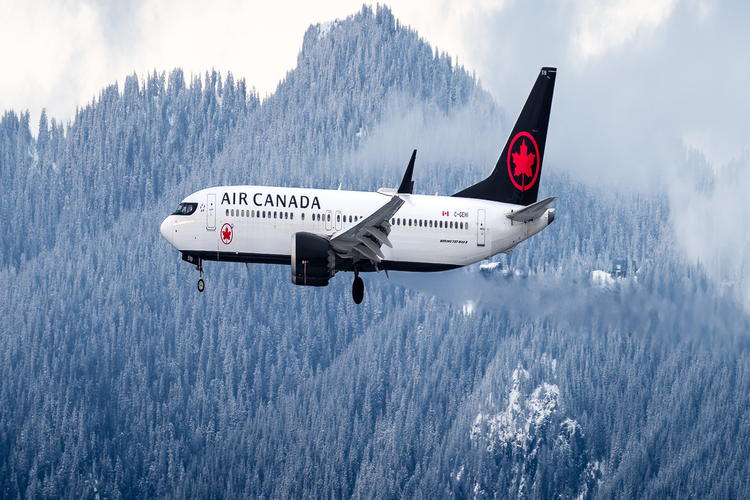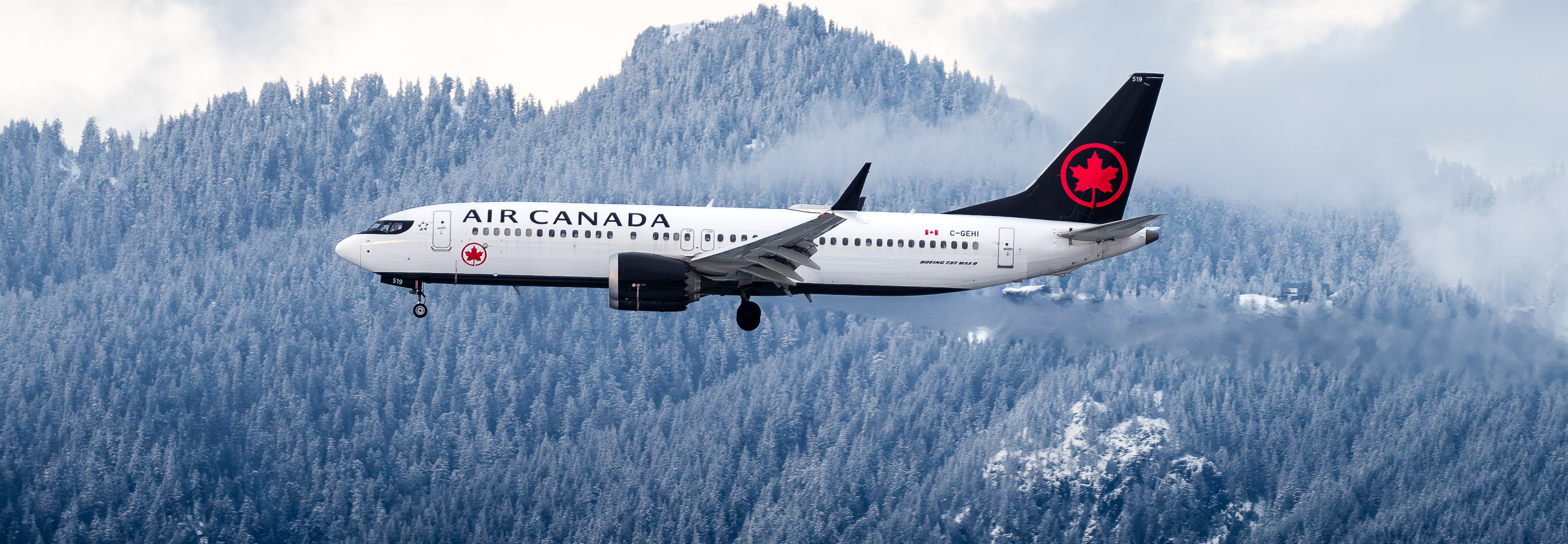Introduction
In addition to the information relating to our climate action initiatives available on our Leave Less website pages and Air Canada’s TCFD disclosure, below is important information on our climate objectives.
Our climate action initiatives are designed to align with the Government of Canada’s 2050 climate change targets, and with the aviation industry’s targets set by the International Air Transport Association (IATA) and by the International Civil Aviation Organization (ICAO).
The path to our 2050 net-zero ambition is complex. We are at the early stages of our journey and are dedicated to working towards all our climate objectives, but our objectives are subject to meaningful risk and uncertainty. There are significant challenges and tremendous work ahead to meaningfully address our contribution to climate change. As we set out in other statements, our climate ambition depends on many factors we do not control, such as the coordinated efforts of industry, suppliers and other stakeholders, actors, as well as governments and their significant support.
Availability of new technologies and sustainable aviation fuel
The key carbon reduction pillars that are central to the advancement of our climate initiatives, particularly as they pertain to new aircraft technologies and sustainable aviation fuels (SAF), are not yet available, at all, or in any meaningful capacity. In addition, there are many unknowns as science and technology are evolving rapidly. As a result, given our growth plans, our gross greenhouse gas (GHG) emissions are not expected to decrease in the near and medium term before these opportunities for decarbonization are commercially available in a meaningful way.
Climate drivers other than CO2 emissions
Our 2050 net-zero aspirational goal is focused on GHG emissions. While CO2 comprises the vast majority of the GHG emissions generated from the combustion of jet fuel that powers our aircraft engines, there are other equally important drivers that need to be addressed as part of our efforts to mitigate the climate impact of our operations. There are also non-CO2 emissions from aviation, such as nitrogen oxides, sulphur oxides, particulate matter, and contrails that are also identified by the scientific community to have varying and potentially significant impacts on climate change. Those are, however, difficult to monitor as no robust methodology, nor mitigating tools currently exist at scale (see IATA, 2024).
Sustainable aviation fuel (SAF)
SAF is an alternative to conventional fossil-based jet fuel. Unlike conventional jet fuels derived from crude oil, SAF is made from alternative feedstocks and must meet various sustainability criteria, which differ depending on the program, country, or specific guidelines. These feedstocks can include used cooking oil, tallow, agricultural residues, waste bi-product materials from forestry, and other biomass-based sources. When requiring significant land, water, and energy resources, these alternative fuels would not be qualified as sustainable aviation fuel. GHG emissions are still emitted when using SAF, however SAF with lower life cycle emissions helps reduce GHG emissions when replacing conventional jet fuel with higher life cycle emissions. GHG emission reductions associated with a given flight using SAF are dependent on a wide range of factors. Also, while SAF is compatible with existing aircraft engines and airport fueling infrastructure, today, SAF can be blended only up to 50 per cent with conventional jet fuel. SAF is costly to source and the current global SAF supply remains very limited and can only satisfy a very small fraction of worldwide demand. In 2024, IATA announced that a tripling of SAF production in 2024 would still only account for 0.53% of aviation's total fuel requirements in 2024.
Carbon offsetting
Carbon offsetting is a term used to describe a mechanism through which individuals and organizations can help support certified third-party projects that contribute to the removal or avoidance of GHG emissions around the world.
Certified projects issue carbon offset credits. Each carbon offset credit, or emission reduction unit aims to represent a single unit of GHG emissions (being one (1) tonne carbon dioxide equivalent (tCO2e)) that is avoided or removed from the atmosphere. A unit of GHG emissions can be avoided or removed from the atmosphere through various projects (e.g. forestry projects, landfill methane recovery and destruction). The certification process for a carbon offset project is verified to ensure the emissions reductions are additional, measurable, auditable, permanent, and unique.
Carbon offset projects are one part of a broader climate strategy to advance global climate action efforts – they do not replace a company’s or an individual's efforts to reduce their GHG emissions. Instead, carbon offsetting should be viewed as supplementary climate action that complements significant broader decarbonization efforts that are required.
Air Canada’s Leave Less Travel Program, offered through its official carbon offset and carbon program collaborator Chooose, allows customers to voluntarily offset the GHG emissions associated with their flight(s) through the purchase of carbon offset credits. Through this program, Air Canada is providing opportunities for passengers to support climate initiatives around the world. The carbon offset credits made available through Chooose are voluntary emission reduction units.
The projects issuing these carbon offset credits are certified to internationally recognized carbon certification standards that set requirements for the design and implementation of projects such as the Verified Carbon Standard, the Gold Standard, American Carbon Registry, and the BC carbon registry. The independent third-party verifications are performed by accredited verifiers and follow best practices as well as the verification criteria indicated in each specific standard. More information on the carbon offset projects that Air Canada customers support through the Leave Less Travel Program are available on the Chooose portal.
Caution regarding forward-looking and other information
The Leave Less webpages may include forward-looking statements within the meaning of applicable securities laws. Forward-looking statements relate to analyses and other information that are based on forecasts of future results and estimates of amounts not yet determinable. These statements may involve, but are not limited to, comments relating to guidance, strategies, expectations, planned operations or future actions. Forward-looking statements are identified using terms and phrases such as “preliminary”, “anticipate”, “believe”, “could”, “estimate”, “expect”, “intend”, “may”, “plan”, “predict”, “project”, “will”, “would”, and similar terms and phrases, including references to assumptions. Forward-looking statements, by their nature, are based on assumptions including those described herein and are subject to important risks and uncertainties.
Forward-looking statements cannot be relied upon due to, among other things, changing external events and general uncertainties of the business of Air Canada. Actual results may differ materially from results indicated in forward-looking statements due to a number of factors, including those discussed below.
Factors that may cause results to differ materially from results indicated in forward-looking statements include economic conditions, statements or actions by governments relating to the imposition of (or threats to impose) tariffs on Canadian exports or imports and their resulting consequences, geopolitical conditions such as the military conflicts in the Middle East and between Russia and Ukraine, Air Canada’s ability to successfully achieve or sustain positive net profitability, industry and market conditions and the demand environment, competition, Air Canada’s dependence on technology, cybersecurity risks, interruptions of service, climate change and environmental factors (including weather systems and other natural phenomena and factors arising from anthropogenic sources), Air Canada’s dependence on key suppliers (including government agencies and other stakeholders supporting airport and airline operations), employee and labour relations and costs, Air Canada’s ability to successfully implement appropriate strategic and other important initiatives (including Air Canada’s ability to manage operating costs), energy prices, Air Canada’s ability to pay its indebtedness and maintain or increase liquidity, Air Canada’s dependence on regional and other carriers, Air Canada’s ability to attract and retain required personnel, epidemic diseases, changes in laws, regulatory developments or proceedings, terrorist acts, war, Air Canada’s ability to successfully operate its loyalty program, casualty losses, Air Canada’s dependence on Star Alliance® and joint ventures, Air Canada’s ability to preserve and grow its brand, pending and future litigation and actions by third parties, currency exchange fluctuations, limitations due to restrictive covenants, insurance issues and costs, and pension plan obligations as well as the factors identified in Air Canada’s public disclosure file available online and, in particular, those identified in “Risk Factors” of Air Canada’s MD&A.
Air Canada has and continues to establish targets, make commitments and assess the impact regarding climate change, and related initiatives, plans and proposals that Air Canada and other stakeholders (including government, regulatory and other bodies) are pursuing in relation to climate change and carbon emissions. The achievement of our commitments and targets depends on many factors, including the combined actions of governments, industry, suppliers and other stakeholders and actors, as well as the development and implementation of new technologies. In particular, our 2030 carbon emission-related targets and our related 2050 aspiration are ambitious and heavily dependent on new technologies, renewable energies and the availability of a sufficient supply of sustainable aviation fuels (SAF), which continues to present serious challenges.
In addition, Air Canada has incurred, and expects to continue to incur, costs to achieve its goal of net-zero carbon emissions and to comply with environmental sustainability legislation and regulation and other standards and accords. The precise nature of future binding or nonbinding legislation, regulation, standards and accords, on which local and international stakeholders are increasingly focusing, cannot be predicted with any degree of certainty, nor can their financial, operational or other impact. There can be no assurance of the extent to which any of our climate goals will be achieved or that any future investments that we make in furtherance of achieving our climate goals will produce the expected results or meet increasing stakeholder environmental, social and governance expectations. Moreover, future events could lead Air Canada to prioritize other nearer-term interests over progressing toward our current climate goals based on business strategy, economic, regulatory and social factors, and potential pressure from investors, activist groups or other stakeholders. If we are unable to meet or properly report on our progress toward achieving our climate change goals and commitments, we could face adverse publicity and reactions from investors, customers, advocacy groups or other stakeholders, which could result in reputational harm or other adverse effects to Air Canada.
The forward-looking statements contained or incorporated by reference on the Leave Less webpages represent Air Canada’s expectations as of the most recent update of these webpages (or as of the date they are otherwise stated to be made) and are subject to change after such date. However, Air Canada disclaims any intention or obligation to update or revise any forward-looking statements, whether because of new information, future events or otherwise, except as required under applicable securities regulations.
Third-party information
In addition, market and industry data and third-party information used on this Leave Less website were obtained from third parties, surveys, market research, publicly available information and industry publications. Industry publications generally state that the information contained therein has been obtained from sources believed to be reliable at the relevant time, but that the accuracy and completeness of such information is not guaranteed. Similarly, third party information, surveys, market research and other publicly available information, while believed to be reliable, have not been independently verified, and Air Canada does not make any representation as to the completeness or accuracy of such information.
References
- SAF is an alternative aviation fuel made from renewable feedstocks other than crude oil. Learn more.
- SAF can be produced without depletion of natural resources. Learn more.
- SAF has lower lifecycle emissions compared to the lifecycle emissions of conventional jet fuel. Learn more.
- SAF is used as a direct replacement (often referred to as a "drop-in fuel") for conventional jet fuel. This means it is compatible with existing aircraft engines and airport fueling infrastructure. Learn more.
- SAF contains less sulfur and other "aromatics," which results in lower particulate emissions and ultimately in decreased air pollution and related negative health impacts. Learn more.


 TCFD
TCFD IEnvA Certification
IEnvA Certification  Environmental Policy
Environmental Policy More information
More information Contact us
Contact us 






 Indicates an external site which may not meet accessibility guidelines.
Indicates an external site which may not meet accessibility guidelines.